Lyxor Euro Stoxx50 Net Return (MSE) - 26/06/2017
Short term strategy : Neutral (20%)
Long term strategy : Positive (65%)
Characteristics of the ETF
MSE (Lyxor) tracks the European Euro Stoxx50 Net return index.
The Euro Stoxx50 Index is composed of the 50 largest stocks in the eurozone which are selected according to their market capitalisation, liquidity and sector representativeness. The index seeks to respect a weighting by country and by economic sector that is a maximum reflection of the economic structure of the eurozone area. This index is dominated by the Franco-German couple, which represents about 70% of the index capitalisation, while the remaining 30% of the index, is mainly consisting in companies coming from the southern European countries (mainly Italy and Spain) and the Benelux.
The 10 largest stocks holdings represent approximately 35% of the index and are large companies in the order of 100 bn€, market capitalization including 6 German companies (Siemens, SAP, Bayer, BASF, Allianz and Daimler) and 2 French (Total and Sanofi). The index is fairly balanced from a sector perspective, most of which is financials (22%), followed by industry (14%), cyclical consumer goods (11%) and durable goods (10%) and healthcare (10%).
With regard to euro area stocks, there is no direct currency risk, however, with respect to large and worldwide based companies, there is a sensitivity to the euro/dollar change. The Euro Stoxx50 is representative of the eurozone economy as a result of its sector weighting, which makes the share of the energy sector lower than in some national indexes (such as the CAC40), while the financial sector (banks + Insurance) remains a key Sub-Fund with 22% of the weighting while below the weight it represents in the Italian or Spanish indexes (c.33%).
MSE replicates the Euro Stoxx50 (physical replication of the index) with low expenses rate (0.2%) and its liquidity amounts to 7 430 M€. The volatility of the Euro Stoxx50 is rather lower than that of national indexes, due to geographical diversification, lack of sector bias and the greatest inertia due to the size of market capitalisations.
The Euro Stoxx50 recorded a slight increase of 0.7% in 2016, while the rise reached 7.7% in 2017 (+9.3% for the Stoxx600 led by Switzerland and the Nordic countries). Looking at the euro Stoxx50 in comparison with the Stoxx600, it is a much more concentrated index focused on the core of the eurozone as a result of the absence of the UK, Switzerland and the Nordic countries, and on the large market capitalisations too. The political cycle has been particularly favourable, with the Liberals victory in the Netherlands and France. Italy is still to vote in 2018 and Germany in September.
The Euro stoxx50 was mainly tracted in 2017 by Ibex35 (+ 13.3%) and DAX30 (+ 10.9%), but the index is slowed down for a few weeks, somewhat penalised by banks which are 22% of the weighting, while the drop in oil prices is a drag on the outlook for inflation. This is not good news for banks that are linked to the yield curve. However, the recovery in European growth should gradually lead to lower unemployment and mechanically higher inflation prospects.
Monthly data
The sharp rise that began in summer 2016 managed to put the Eurostoxx50 on a long-term upward trend. For the past 2 months this bullish wave is being consolidated, but for the time being without great volatility or particularly marked slump. Given the importance of the wave to consolidate (27% since June 2016), it would not be surprising that this consolidation last for a while, and eventually go for a correction, before starting a next wave of rise.
Weekly data
The analysis of weekly charts shows that the short term configuration is turning bearish. Prices has stalled for several weeks, without a bullish rebound, which eventually triggered a downward crossing signal from the MACD. The upward trend has just been broken on the RSI, which came as a confirmation. M13 is still holding as a support, but a bearish breakout could occur at any time.
A correction is underway, of which influence is spreading into the medium term. Caution.
ETF objective
MSE is a UCITS compliant ETF that aims to track the benchmark index EURO STOXX 50 Net Total Return Index.
France and Germany represents 70% of the index capitalisation
Characteristics
| Inception date | 19/02/2001 |
| Expenses | 0,20% |
| Benchmark | Euro Stoxx 50 Net Return |
| Issuer | Lyxor |
| Ticker | MSE |
| ISIN | FR0007054358 |
| UCITS | Yes |
| EU-SD Status | Out of scope |
| Currency | € |
| Exchange | Euronext Paris |
| Asset Under Management | 7 430 M€ |
| Replication method | Direct (Physical) |
| Dividend | Capitalisation |
| PEA (France) | Yes |
| SRD (France) | Yes |
| Currency Risk | No |
| Number of Holdings | 50 |
| Risk | 3/5 |
Country Breakdown
| France | 36% |
| Germany | 33% |
| Spain | 11% |
| Netherlands | 6% |
| Italy | 5% |
| Belgium | 3% |
| Others | 6% |
Sector Breakdown
| Financials | 22% |
| Industrials | 15% |
| Consumer Discretionary | 11% |
| Consumer Staples | 11% |
| Health Care | 11% |
| Information Technology | 7% |
| Materials | 6% |
| Others | 17% |
Top Ten Holdings
| Total | 5% |
| Siemens | 4% |
| Sanofi | 4% |
| Bayer | 4% |
| SAP | 4% |
| Banco Santander | 4% |
| Unilever | 3% |
| Allianz | 3% |
| AB Inbev | 3% |
| BASF | 3% |


